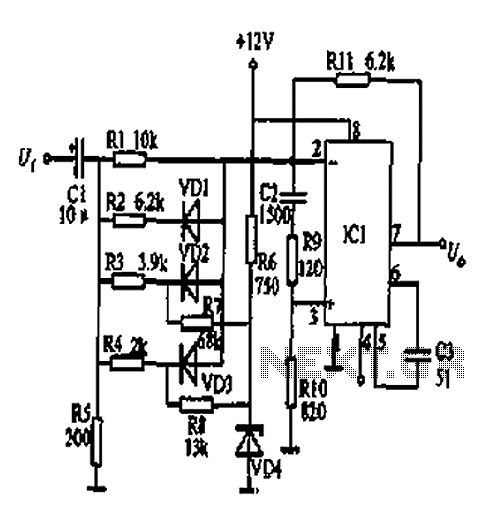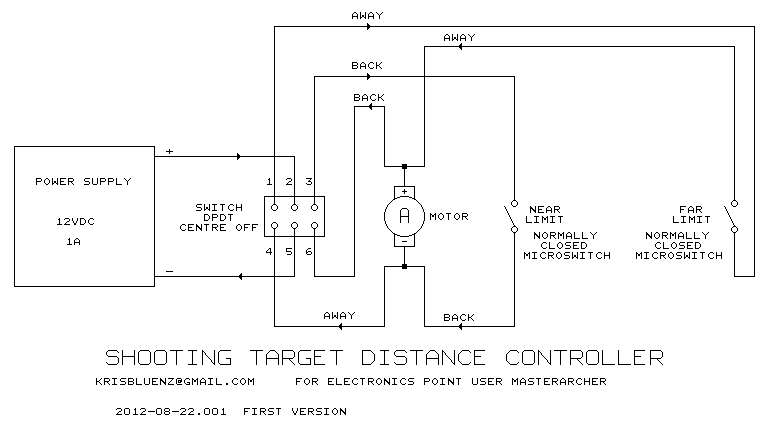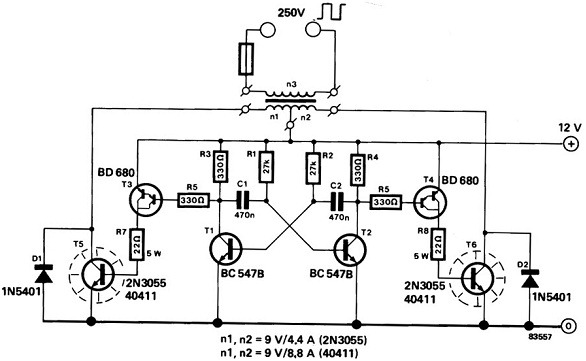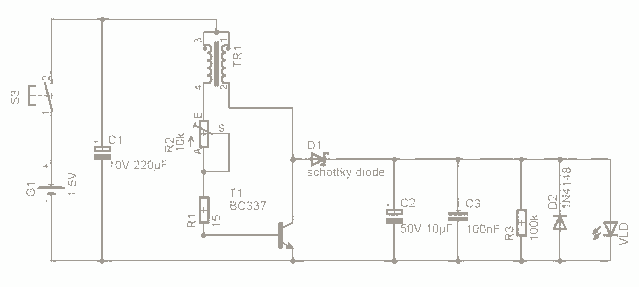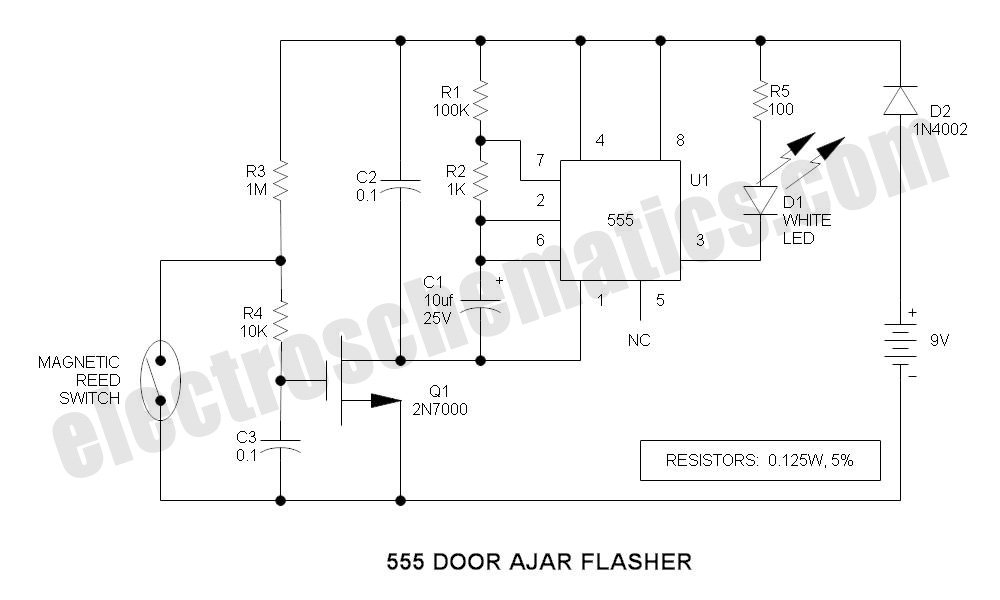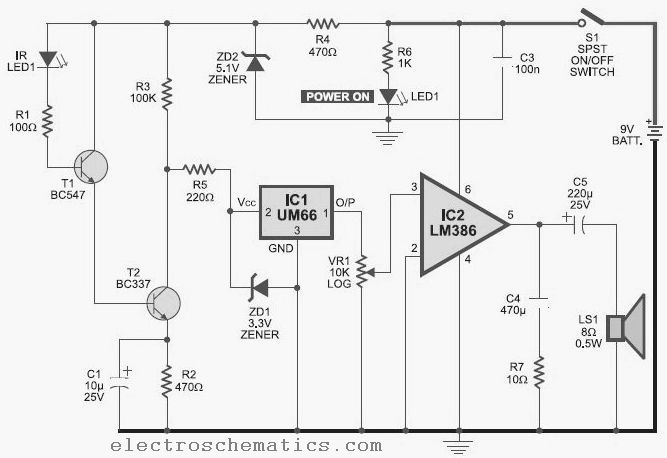
Emitter negative feedback differential amplifier gain control circuit
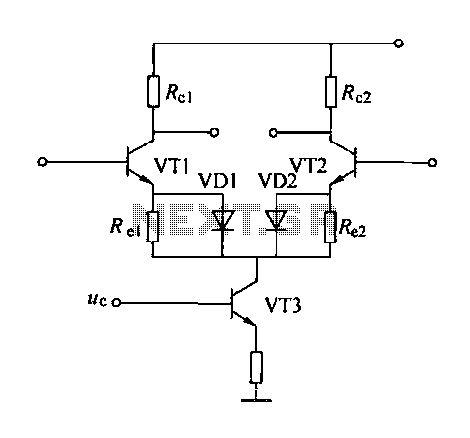
A controllable gain amplifier functions as an automatic gain control circuit within the execution unit. The primary methods for controlling the amplifier's gain involve two approaches: one is by adjusting certain parameters of the amplifier itself, such as emitter current, load current distribution ratio, and constant current source, to manage the magnitude of negative feedback gain. The second method involves inserting a controllable attenuator to modify the amplifier's gain. The circuit diagram for the emitter negative feedback differential amplifier gain control is provided. Reference values for component parameters are as follows: 1) transistors: 3DG6, 2CP41 diode; 2) resistances: R1 and R2 are 5.1 kΩ, R1, R2, and Ra are 1 kΩ. The differential amplifier is composed of transistors VT1 and VT2, with the signal fed into the bases of these two transistors, providing a differential output from the collectors. The circuit includes VT3, which connects to two diodes (VD1, VD2) and a resistor (R), forming an emitter degeneration network. The resistors R1, R2, R3, Rcl, and Rtz, along with diodes VD1 and VD2, determine the conduction state based on the voltage drop across R1 and R2. When the control voltage (U) is low, the collector current (Ic) is small, and the average current flowing through R2 is half of Ic3. As the resistance (kRt/2) is less than the diode's turn-on voltage, diodes VD1 and VD2 remain off, resulting in the minimum gain of the differential amplifier. As the control voltage increases, Ic also increases, causing the current through R2 to exceed the conduction voltage of VD1 and VD2, allowing them to conduct. The dynamic range of the gain control circuit indicates that the control voltage should decrease as the input signal increases.
The controllable gain amplifier is designed to provide precise gain adjustments in response to varying input signal levels. The differential amplifier configuration utilizing transistors VT1 and VT2 allows for a balanced response to the input signals, ensuring that the output maintains fidelity. The use of emitter degeneration via resistors and diodes helps stabilize the gain and improve linearity by reducing the effects of variations in temperature and transistor parameters.
The reference components specified, such as the 3DG6 transistors and 2CP41 diodes, are chosen for their performance characteristics suitable for amplifier applications. The resistor values are critical in determining the amplifier's gain, with R1 and R2 providing the necessary feedback to maintain stability. The controllable attenuator implemented in the circuit allows for additional flexibility in gain adjustment, enabling the amplifier to adapt to fluctuating signal conditions effectively.
This design is particularly useful in applications requiring automatic gain control, such as audio processing, RF signal amplification, and instrumentation. By maintaining a consistent output level despite variations in input signal strength, the controllable gain amplifier enhances the overall performance and reliability of electronic systems. The careful selection of components and configuration ensures that the amplifier can handle a wide range of input conditions while minimizing distortion and maximizing signal integrity.Controllable gain amplifier is an automatic gain control circuit of the execution unit, the main method of controlling the gain of the amplifier in two ways: One way is through changing some parameters of the amplifier itself. As the emitter current, the load current distribution ratio, constant current source, and so to control the size of the negative feedback gain; Another method is to insert a controllable attenuator change the gain of the amplifier. Emitter negative feedback differential amplifier gain control circuit diagram shown. Component Parameters Reference values are as follows: 1) transistors 3DG6 2. 2CP41 diode. 2) Resistance: R. l a R spit a 5.lkfl, R. 1 a ReZ a Ra lkfl. VT1 and VT2 composed of the differential amplifier, the signal from VT1, VT2 base of two double-ended input, a collector from two double-ended output control signal.
Note from VT3 base into the two diodes VD1, VD2 and resistor R., ruler. composing emitter degeneration, and there R.l -Rcz -Rr, Rcl Rtz R. diodes VD1, VD2 conduction or not depends on Rel and R sweet drop. when the control voltage u. is small, IcJ small, and the average current flowing through the R. Re2 on each of Ie3/2. as kRt/2 is smaller than the diode turn-on voltage of the diode VD1, VD2 cut stop, then the minimum gain of the differential amplifier when the control voltage it increases, I increase, so Iea Re/2 is greater than the diode conduction voltage is VD1, VD2 conduction, conduction resistance rd will conduct current ID as Yun increases. visible, use when this gain control circuit, the control voltage H. should decreases as the input signal.
The controllable gain amplifier is designed to provide precise gain adjustments in response to varying input signal levels. The differential amplifier configuration utilizing transistors VT1 and VT2 allows for a balanced response to the input signals, ensuring that the output maintains fidelity. The use of emitter degeneration via resistors and diodes helps stabilize the gain and improve linearity by reducing the effects of variations in temperature and transistor parameters.
The reference components specified, such as the 3DG6 transistors and 2CP41 diodes, are chosen for their performance characteristics suitable for amplifier applications. The resistor values are critical in determining the amplifier's gain, with R1 and R2 providing the necessary feedback to maintain stability. The controllable attenuator implemented in the circuit allows for additional flexibility in gain adjustment, enabling the amplifier to adapt to fluctuating signal conditions effectively.
This design is particularly useful in applications requiring automatic gain control, such as audio processing, RF signal amplification, and instrumentation. By maintaining a consistent output level despite variations in input signal strength, the controllable gain amplifier enhances the overall performance and reliability of electronic systems. The careful selection of components and configuration ensures that the amplifier can handle a wide range of input conditions while minimizing distortion and maximizing signal integrity.Controllable gain amplifier is an automatic gain control circuit of the execution unit, the main method of controlling the gain of the amplifier in two ways: One way is through changing some parameters of the amplifier itself. As the emitter current, the load current distribution ratio, constant current source, and so to control the size of the negative feedback gain; Another method is to insert a controllable attenuator change the gain of the amplifier. Emitter negative feedback differential amplifier gain control circuit diagram shown. Component Parameters Reference values are as follows: 1) transistors 3DG6 2. 2CP41 diode. 2) Resistance: R. l a R spit a 5.lkfl, R. 1 a ReZ a Ra lkfl. VT1 and VT2 composed of the differential amplifier, the signal from VT1, VT2 base of two double-ended input, a collector from two double-ended output control signal.
Note from VT3 base into the two diodes VD1, VD2 and resistor R., ruler. composing emitter degeneration, and there R.l -Rcz -Rr, Rcl Rtz R. diodes VD1, VD2 conduction or not depends on Rel and R sweet drop. when the control voltage u. is small, IcJ small, and the average current flowing through the R. Re2 on each of Ie3/2. as kRt/2 is smaller than the diode turn-on voltage of the diode VD1, VD2 cut stop, then the minimum gain of the differential amplifier when the control voltage it increases, I increase, so Iea Re/2 is greater than the diode conduction voltage is VD1, VD2 conduction, conduction resistance rd will conduct current ID as Yun increases. visible, use when this gain control circuit, the control voltage H. should decreases as the input signal.
